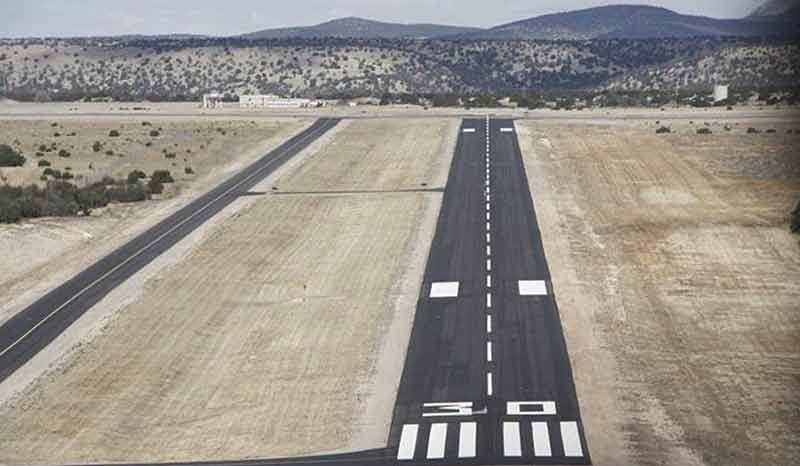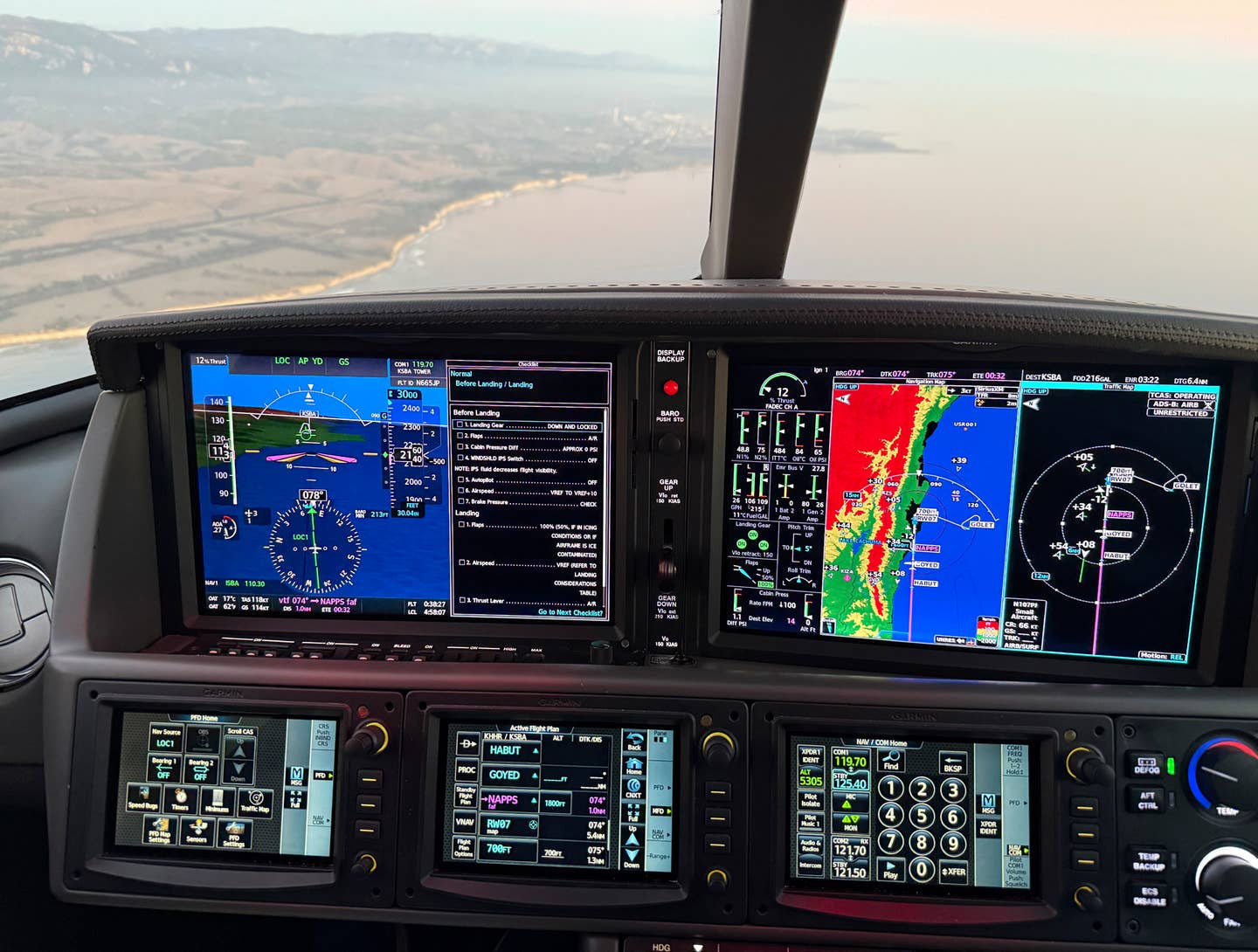
A Cessna T310R making its final approach to Sierra Blanca Regional Airport (pictured) in Ruidoso, New Mexico, crashed and resulted in five deaths. Sierra Blanca Regional Airport
In June 2010, a Cessna T310R crashed in fine weather while on final approach at Ruidoso, New Mexico. Five people perished, two survived. The survivors were 12 and 16 years old, and I suspect that they were probably in the aftmost seats. Another young person, an 11-year-old boy, was double-belted in the right front seat with his mother.
Parenthetically, FAR 91.107, which concerns seat belts, does not explicitly forbid the practice of double-belting. The rule says everyone (except children under 2) must occupy a seat with safety belts, but does not stipulate that all passengers be in different seats. After this accident, the National Transportation Safety Board (NTSB) urged the FAA to amend the rule, but the FAA chose not to do so.
The 310 is intended to carry only six people, including the pilot, but despite the overpopulation the NTSB concluded that the airplane’s weight and CG location were within limits and loading was not the cause of the accident. The cause was, instead, a familiar and banal one: The pilot got too slow, and the airplane stalled and departed into an incipient spin. “Contributing to the accident,” the NTSB went on, “was the pilot’s limited experience in the airplane make and model.”
I would suggest, however, that the loading probably did have something to do with it.
The private pilot, 49, had around 850 hours. In an insurance document associated with his acquisition of the 310 three months before the accident, he reported 156 hours of multiengine time, including five hours in Cessna 310s. The pilot’s insurance policy required that he receive five hours of dual instruction in the 310 (three of them instrument dual, although he did not have an instrument rating) before he would be covered to fly solo. Two months before the accident, he logged 3.1 hours of instruction in the accident airplane; no record of subsequent flights was found.
That the pilot did not feel entirely familiar with the airplane is suggested by the fact that he and one passenger took off from the 3,600-foot runway of their hometown — in flat country, near sea level — and flew 20 miles to another airport with a 5,700-foot runway to emplane the other five. If this was a precaution, it was a superfluous one; even at gross weight, the T310R clears a 50-foot obstacle in less than 1,700 feet from brake release.
The density altitude at Ruidoso was 9,500 feet when the 310 arrived. The pilot radioed on the common traffic advisory frequency to report 30 miles out, then 10 miles, and said that he intended to land on Runway 24. The wind at the time was 050 at 5 knots, so he would be landing with a slight tailwind.
The pilot had most likely obtained the airport weather from the AWOS broadcast, and decided to land on Runway 24 because it lay in more or less the direction he was pointing and the wind seemed insignificant. Generally, a circuit is preferable to a straight-in approach when arriving at an uncontrolled field, to improve the chances of seeing traffic and being seen; but at least the pilot did make two position reports as he approached.
After the pilot’s 10-mile call, two line persons drove across the ramp in a golf cart to await the Cessna’s arrival. They spotted the airplane when it was 3 miles out; the line foreman, who had worked at the airport for 25 years, thought it looked a little high. It began a gradual descent, which was followed by a rapid descent into what the foreman estimated was a 60-degree dive. Another witness said that the airplane “suddenly [went] straight down.” Moments later, dust and smoke rose from a point about 1,300 feet short of the runway.
There had been no distress call. Examination of the wreckage, which was partially consumed by fire, yielded no evidence of a mechanical problem. The way the propellers were scored and bent indicated that both had been under power at impact. Unexpectedly, the right tank had been feeding the left engine and the left tank the right, but although that is not the recommended practice there is nothing about it to cause a stall-spin. The split flaps had been set at 20 degrees of an available 35 — an apparent oversight if the pilot was trying to achieve a steeper approach.
The NTSB’s opinion of the “likely” scenario was that “the pilot, when he realized the airplane was high on approach, reduced the airplane’s airspeed and raised the nose in order to more rapidly decrease its altitude.”
The accident report says nothing about the types of twin-engine airplanes the pilot had flown before he bought the 310. It may be that the 310 was a heavier, faster airplane than he was used to, but maybe not. At any rate, the mere three hours of logged time in the accident airplane before the fatal trip — and that with only him and an instructor aboard — suggests that the pilot was in unfamiliar territory landing a fully loaded 310 at a very high-density altitude.
How fast the airplane was actually going is unknown. The POH recommends an approach speed of 93 knots. At a 9,500-foot density altitude, 93 kias yields a groundspeed of 107 knots. To this must be added 5 knots for the tailwind, or probably more, since the wind speed would likely increase with altitude. Even if it flew at precisely the recommended approach speed, the 310’s groundspeed could have approached 120 knots.
Excess speed on approach naturally leads to excess height, but also becomes more obvious as the airplane gets lower. The airplane begins to “feel” excessively fast. Whether the pilot reduced speed because he thought it would increase his rate (or, more properly, angle) of descent, as the NTSB believes, or because he simply perceived himself as moving over the ground too rapidly, as I would suggest, something caused him to raise the nose.
The 310R stalls at 79 knots clean and 72 knots (some sources say 70) with gear and flaps down; probably at 75 knots or so with flaps 20. Aft CG reduces longitudinal stability and makes the airplane more sensitive to small pitch commands; some combination of unaccustomed loading, confusing visual impressions of excess speed and lack of familiarity with the feel of the airplane caused the pilot to bleed off — unwittingly, I assume — the 18-knot cushion that separated approach speed from stalling speed. One of the surviving passengers reported that the wings were rocking and he felt the airplane being “tossed around” by wind. The wing rock and the sensation of being tossed around were very likely due to the wing beginning to stall. By the time it occurred, the airplane was probably less than 200 feet above the ground, a height at which the proper reaction to an inadvertent stall, pushing the nose down smartly, may be overwhelmed by an instinctive, and fatal, impulse to pull back on the yoke.
A great many accidents, most of them fatal, are due to stalling during an approach to a landing. Usually the airplane is turning when control is lost; it’s comparatively unusual for a stall-spin to occur during a straight-in approach because stalling speed is lower with wings level than in a banked turn.
In a world of long, wide paved runways and docile tri-gear airplanes with powerful brakes, careful speed control on approach may seem pointless. As a practical matter, it usually is. But precise attention to speed is occasionally vital; and it’s at those times that having held oneself to a high standard of precision at other times finally pays off.

Sign-up for newsletters & special offers!
Get the latest FLYING stories & special offers delivered directly to your inbox






